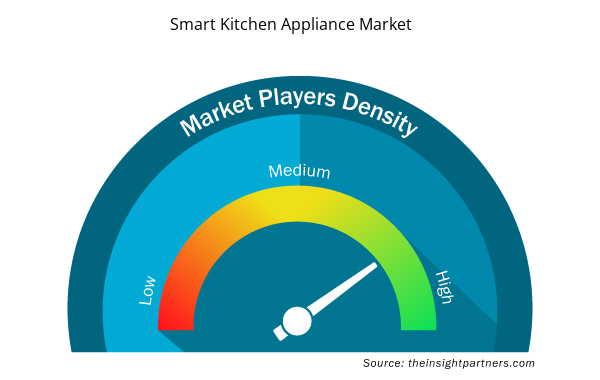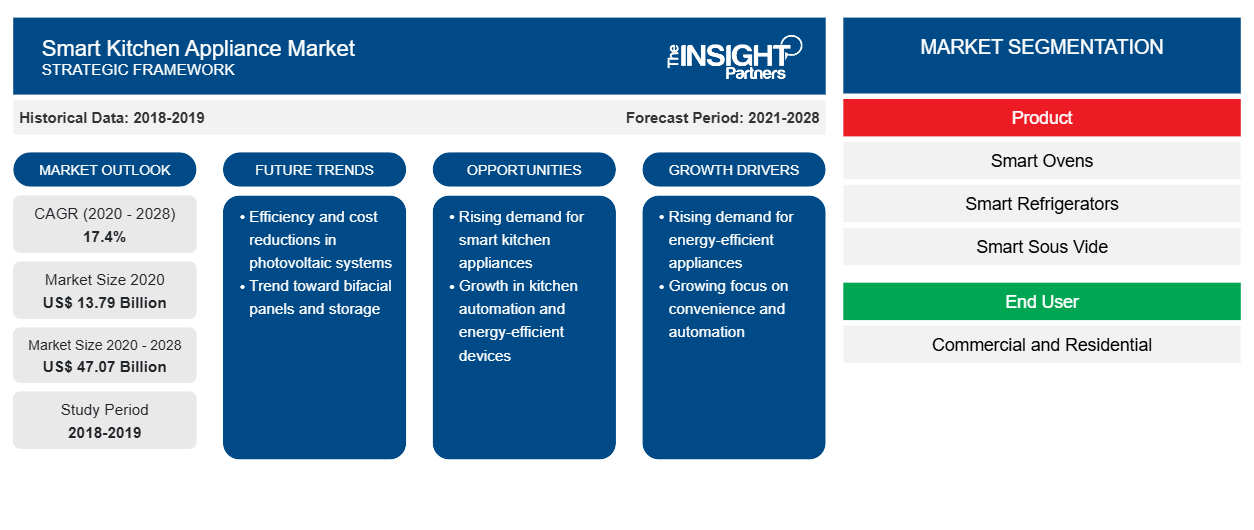全球智能厨房电器市场预计将从 2020 年的 137.86 亿美元增长到 2028 年的 470.712 亿美元;预计 2020-2028 年期间的复合年增长率为 17.4%。
智能厨房电器的成本效益和通信能力
智能厨房电器是最近创新的技术,在发达国家和发展中国家都越来越受欢迎。根据思科互联网报告,联网家庭将占据所有物联网 (IoT) 应用中 48% 的份额。智能厨房电器为业主提供了多种好处,例如成本效益、通信能力、安全性和便利性,从而吸引了最终用户的注意。
采购智能厨房电器的初期投资较高。然而,从长远来看,这些电器可以帮助客户减少与定期维护和能源消耗相关的经常性成本。传统或现代电子或电器节省的能源较少,但需要定期维护,成本较高。智能厨房电器中集成的传感器技术使设备能够感知性能并在出现任何故障时提醒所有者。这一因素降低了重复成本。例如,LG ThinQ 是 LG 电子为其智能电器提供的一款智能手机应用程序。智能电器由自我诊断功能驱动,最终用户可以使用 LG ThinQ 应用程序访问诊断结果。此外,该应用程序还为用户提供必要的故障排除指导以诊断问题,从而无需就小问题联系维修人员。经常性费用的减少促使许多最终用户购买这些智能厨房电器。
同样,智能厨房电器的另一个优势是能够通过无线网络进行通信。这些厨房电器可以通过主人的智能手机相互通信并与主人通信。智能技术使主人能够远程控制、监控和访问电器。智能烤箱等智能厨房电器允许主人通过智能手机关闭或打开炉灶,从而增加了便利性。这一好处正在增加终端用户对它们的需求。此外,通过集成各种传感器和内置摄像头,智能冰箱方便主人更新购物清单。
此外,智能冰箱还配有屏幕,可用作记事本并检查温度和能耗模式。智能冰箱的拥有者可以根据冰箱的性能轻松控制和管理冰箱,并通过智能手机在各种模式之间切换。智能冰箱的这些优势使客户能够为商业和住宅用途购买智能冰箱,从而推动智能厨房电器市场的增长
定制此报告以满足您的需求
您可以免费定制任何报告,包括本报告的部分内容、国家级分析、Excel 数据包,以及为初创企业和大学提供优惠和折扣
- 获取此报告的关键市场趋势。这个免费样品将包括数据分析,从市场趋势到估计和预测。
COVID-19 疫情对智能厨房电器市场的影响
据电子元件行业协会称,COVID-19 导致供应链、产品发布、活动和其他行业相关活动的延迟和中断。由于防控措施和零部件和原材料供应有限,多家电子制造商不得不暂时关闭生产部门。此外,包括智能厨房电器在内的各种电子和半导体产品制造商都经历了规定时间表的延迟,这对智能厨房电器市场的供应链产生了负面影响。然而,随着经济重新开放和市场从 2021 年开始获得积极势头,智能厨房电器市场的供应链在 2020 年第四季度末开始稳定下来。
智能厨房电器市场洞察
智能家居和智能酒店项目大幅增长
全球建筑行业对配备先进技术设备和装置的联网住宅的需求巨大。美国和英国等发达国家以及中国、日本和韩国等发展中国家在智能家居发展方面取得了令人瞩目的进展。美国市场见证了智能住宅数量的大幅增长,预计未来几年美国也将出现类似的趋势。美国人口思维方式的快速转变严重影响了智能音箱、智能恒温器、智能照明和智能安全设备等智能家电的增长。据 Alarm.org 称,57% 的美国人承认,通过使用智能产品,他们可以节省约 30 分钟的时间。约 47% 的千禧一代正在使用智能家居产品。这些设备的采用率在美国和全球范围内不断上升。这些智能设备的普及为智能厨房电器开辟了增长途径,因为这些电器是必需的家居用品之一。由于全球人口观念的变化,主要是发达国家和少数发展中国家的人们,智能厨房电器的未来前景光明。
此外,不同地区的酒店业都在采购机器人技术和联网技术,以提高客户满意度。智能电视、语音控制房间、机器人行李寄存和数字礼宾是当前一些突出的智能酒店技术。各家酒店管理层都表现出浓厚的兴趣,希望通过采购智能厨房电器将厨房改造成智能厨房。基于云的技术与智能手机的结合使酒店和餐馆老板能够远程控制和监控他们的商用厨房电器,从而促进当前情况下智能厨房电器市场的发展。
基于产品的市场洞察
根据产品,智能厨房电器市场细分为智能烤箱、智能冰箱、智能真空低温烹调、智能榨汁机和搅拌机、智能炊具和烹饪机器人、智能炉灶、智能和集成烤箱和炉灶等。智能冰箱细分市场在 2020 年以 33.0% 的份额领先智能厨房电器市场。由于发达国家和发展中国家对智能冰箱和智能烤箱的需求巨大、生活方式改善、互联网基础设施增强、物联网 (IoT) 大幅增长以及住宅和商业厨房对联网设备或电器的需求增加,智能厨房电器市场正在经历激增。
2018 年,智能冰箱占据了全球智能厨房家电市场的最大份额,预计在 2021-2028 年期间将占据市场主导地位。另一方面,预计智能烤箱的需求将在未来几年大幅增长,从而预示着 2021 年至 2028 年期间该领域前景光明。
基于连通性的市场洞察
根据连接性,智能厨房电器市场分为 Wi-Fi 和蓝牙。2020 年,Wi-Fi 领域以 77.3% 的份额领先于智能厨房电器市场。此外,预计到 2028 年将占据 79.0% 的份额。
随着先进传感器、交互式显示屏、摄像头和其他技术的融合,厨房电器正变得越来越智能。这些技术的融合有助于制造商吸引大量客户并增加收入。这使得制造商能够使用 Wi-Fi 连接技术等附加技术升级其产品线。
如今,Wi-Fi 已成为各个地区家庭必不可少的组成部分。智能厨房电器制造商越来越多地将其产品与支持 Wi-Fi 的连接技术解决方案集成在一起,让业主能够从远程位置操作和监控他们的烹饪电器。支持 Wi-Fi 的智能烹饪电器可帮助业主控制和监控两个主要参数——温度和时间。这些优势促使住宅和商业终端用户采购具有 Wi-Fi 连接技术的智能厨房电器。采购量的增加带来了市场增长。快速改善的互联网基础设施对支持 Wi-Fi 的智能厨房电器的增长起着关键作用。根据思科年度互联网报告,物联网设备将占所有联网设备的 50%,其中约三分之一将是无线的。预计这一因素将在未来几年推动具有 Wi-Fi 连接技术的智能厨房电器的增长。
智能烤箱、智能冰箱、智能炉灶、智能咖啡自动售货机、智能榨汁机和搅拌机都是市场上可用的支持 Wi-Fi 的智能厨房电器。消费者对将厨房电器与 Wi-Fi 连接技术相结合的需求日益增加,这推动了 Wi-Fi 连接技术在智能厨房电器中的应用。这一因素是当前支持 Wi-Fi 的智能厨房电器市场的关键催化剂。
智能厨房电器
智能厨房电器市场区域洞察
Insight Partners 的分析师已详细解释了预测期内影响智能厨房电器市场的区域趋势和因素。本节还讨论了北美、欧洲、亚太地区、中东和非洲以及南美和中美洲的智能厨房电器市场细分和地理位置。

- 获取智能厨房电器市场的区域特定数据
智能厨房电器市场报告范围
| 报告属性 | 细节 |
|---|---|
| 2020 年市场规模 | 137.9亿美元 |
| 2028 年市场规模 | 470.7亿美元 |
| 全球复合年增长率(2020 - 2028) | 17.4% |
| 史料 | 2018-2019 |
| 预测期 | 2021-2028 |
| 涵盖的领域 | 按产品
|
| 覆盖地区和国家 | 北美
|
| 市场领导者和主要公司简介 |
|
智能厨房电器市场参与者密度:了解其对业务动态的影响
智能厨房电器市场正在快速增长,这得益于终端用户需求的不断增长,而这些需求又源于消费者偏好的不断变化、技术进步以及对产品优势的认识不断提高等因素。随着需求的增加,企业正在扩大其产品范围,进行创新以满足消费者的需求,并利用新兴趋势,从而进一步推动市场增长。
市场参与者密度是指在特定市场或行业内运营的企业或公司的分布情况。它表明在给定市场空间中,相对于其规模或总市场价值,有多少竞争对手(市场参与者)存在。
在智能厨房电器市场运营的主要公司有:
- 伊莱克斯
- 布雷维尔集团有限公司
- BSH 家用电器有限公司
- 通用电器
- LG 电子公司
免责声明:上面列出的公司没有按照任何特定顺序排列。

- 了解智能厨房电器市场顶级关键参与者概况
智能厨房电器市场的参与者采用合并、收购和市场计划等策略来保持其在市场中的地位。以下列出了一些主要参与者的发展:
- 2019 年 11 月,伊莱克斯扩大了与谷歌的合作,将欧洲的联网厨房产品与谷歌助手相结合,使消费者能够通过语音命令控制产品。
全球智能厨房电器市场细分为产品、最终用户和连接性。根据产品,智能厨房电器市场细分为智能烤箱、智能冰箱、智能真空低温烹调器、智能榨汁机和搅拌机、智能炊具和烹饪机器人、智能炉灶、智能和集成烤箱和炉灶等。根据最终用户,市场分为商业和住宅。根据连接性,智能厨房电器市场细分为 Wi-Fi 和蓝牙。
伊莱克斯 AB、BSH Hausgeräte GmbH、GE Appliances、LG Electronics、荷兰皇家飞利浦 NV、松下电器、三星电子有限公司、Breville Group Limited、惠而浦公司和 Vita-Mix Corporation 是本次研究考虑的主要智能厨房电器市场参与者。此外,本研究报告还研究和分析了其他几家重要的智能厨房电器市场参与者,以全面了解全球智能厨房电器市场及其生态系统。
- 历史分析(2 年)、基准年、预测(7 年)及复合年增长率
- PEST 和 SWOT 分析
- 市场规模价值/数量 - 全球、区域、国家
- 行业和竞争格局
- Excel 数据集


- Lymphedema Treatment Market
- Biopharmaceutical Contract Manufacturing Market
- Influenza Vaccines Market
- Battery Testing Equipment Market
- Green Hydrogen Market
- Architecture Software Market
- Digital Pathology Market
- Intraoperative Neuromonitoring Market
- Hydrogen Storage Alloys Market
- Saudi Arabia Drywall Panels Market

Report Coverage
Revenue forecast, Company Analysis, Industry landscape, Growth factors, and Trends

Segment Covered
This text is related
to segments covered.

Regional Scope
North America, Europe, Asia Pacific, Middle East & Africa, South & Central America

Country Scope
This text is related
to country scope.
常见问题
growth in internet penetration and awareness related to the smart kitchen appliances among the population in developing countries are helping customers in these regions to procure an increased number of smart kitchen appliances, thereby, creating growth opportunities for the smart kitchen appliances market players.
The connected home devices industry has witnessed significant growth across the globe in the current scenario, and the same is expected to be adopted in large quantities in the coming years. Several manufacturers of electronics and electrical equipment are increasingly emphasizing on the development of smart kitchen appliances to benefit their customers with advanced technologies. The presence of long-established and industry recognized manufacturers in the smart kitchen appliance market is facilitating the market to proliferate quickly. Additionally, rising disposable income among the middle-class societies in developed countries and developing countries is influencing the residential end users to adopt newer technologies such as intelligent kitchen appliances, which is paving the growth path for smart kitchen appliance market.
The major companies in smart kitchen appliances includes Whirlpool Corporation; Breville Group Limited; Samsung Electronics Co., Ltd.; Electrolux AB; and BSH Hausgeräte GmbH.
The smart refrigerator is expected to dominate the market during the forecast period. Smart refrigerators are also known internet refrigerators which are embedded with advanced technologies to sense the stored products and keep a track of the stock of products. The ability to communicate with the end users is a prime benefit of smart refrigerators. Various smart refrigerators have large screens which facilitate as note pads, calendar, leave notes, internet browsing, voice assistance, and playing music among others. Also, smart refrigerator allows end user to track the checks expiration dates of most of groceries and also suggests recipes according to groceries available in refrigerator. The sensors embedded in these refrigerators also senses the temperatures outside and inside the fridge,and adjusts the temperatures inside the refrigerators. Additionally, in case of any malfunction, the refrigerators alert the owner immediately which simplifies operational maintenance.
The Wi-Fi is expected to dominate the market during the forecast period. Wi-Fi has become an essential household component nowadays across geographies. Pertaining to this, the manufacturers of smart kitchen appliances are increasingly integrating their products with Wi-Fi enabled Connectivity Technology solutions, which facilitates the owner’s to operate and monitor their cooking appliances from a remote location. Wi-Fi enabled smart cooking appliances helps the owner to control and monitor two major parameters namely; temperature, and time. These benefits have influenced both residential and commercial end users to procure smart kitchen appliances with Wi-Fi Connectivity Technology. Increasing procurement has resulted in market growth. Rapidly improving internet infrastructures in developed countries and developing countries is playing a crucial role in growth of Wi-Fi enabled smart kitchen appliances. According to Cisco Annual Internet Report, IoT devices will account for 50 percent of all networked devices and approximal one-third will be wireless. This factor is anticipated to fuel the growth of smart kitchen appliances with Wi-Fi Connectivity Technology in the forthcoming years.
In 2020, APAC accounted for the highest market share in the global market and is also expected to grow with the highest CAGR over the forecast period.
Trends and growth analysis reports related to Electronics and Semiconductor : READ MORE..
The List of Companies - Smart Kitchen Appliance Market
- AB Electrolux
- Breville Group Limited
- BSH Hausgerate GmbH
- GE Appliance
- LG Electronics inc.
- Panasonic corporation
- KONINKLIJKE PHILIPS N.V.
- Samsung electronics Co., Ltd.
- Vita-Mix Corporation
- Whirlpool Corporation
The Insight Partners performs research in 4 major stages: Data Collection & Secondary Research, Primary Research, Data Analysis and Data Triangulation & Final Review.
- Data Collection and Secondary Research:
As a market research and consulting firm operating from a decade, we have published and advised several client across the globe. First step for any study will start with an assessment of currently available data and insights from existing reports. Further, historical and current market information is collected from Investor Presentations, Annual Reports, SEC Filings, etc., and other information related to company’s performance and market positioning are gathered from Paid Databases (Factiva, Hoovers, and Reuters) and various other publications available in public domain.
Several associations trade associates, technical forums, institutes, societies and organization are accessed to gain technical as well as market related insights through their publications such as research papers, blogs and press releases related to the studies are referred to get cues about the market. Further, white papers, journals, magazines, and other news articles published in last 3 years are scrutinized and analyzed to understand the current market trends.
- Primary Research:
The primarily interview analysis comprise of data obtained from industry participants interview and answers to survey questions gathered by in-house primary team.
For primary research, interviews are conducted with industry experts/CEOs/Marketing Managers/VPs/Subject Matter Experts from both demand and supply side to get a 360-degree view of the market. The primary team conducts several interviews based on the complexity of the markets to understand the various market trends and dynamics which makes research more credible and precise.
A typical research interview fulfils the following functions:
- Provides first-hand information on the market size, market trends, growth trends, competitive landscape, and outlook
- Validates and strengthens in-house secondary research findings
- Develops the analysis team’s expertise and market understanding
Primary research involves email interactions and telephone interviews for each market, category, segment, and sub-segment across geographies. The participants who typically take part in such a process include, but are not limited to:
- Industry participants: VPs, business development managers, market intelligence managers and national sales managers
- Outside experts: Valuation experts, research analysts and key opinion leaders specializing in the electronics and semiconductor industry.
Below is the breakup of our primary respondents by company, designation, and region:

Once we receive the confirmation from primary research sources or primary respondents, we finalize the base year market estimation and forecast the data as per the macroeconomic and microeconomic factors assessed during data collection.
- Data Analysis:
Once data is validated through both secondary as well as primary respondents, we finalize the market estimations by hypothesis formulation and factor analysis at regional and country level.
- Macro-Economic Factor Analysis:
We analyse macroeconomic indicators such the gross domestic product (GDP), increase in the demand for goods and services across industries, technological advancement, regional economic growth, governmental policies, the influence of COVID-19, PEST analysis, and other aspects. This analysis aids in setting benchmarks for various nations/regions and approximating market splits. Additionally, the general trend of the aforementioned components aid in determining the market's development possibilities.
- Country Level Data:
Various factors that are especially aligned to the country are taken into account to determine the market size for a certain area and country, including the presence of vendors, such as headquarters and offices, the country's GDP, demand patterns, and industry growth. To comprehend the market dynamics for the nation, a number of growth variables, inhibitors, application areas, and current market trends are researched. The aforementioned elements aid in determining the country's overall market's growth potential.
- Company Profile:
The “Table of Contents” is formulated by listing and analyzing more than 25 - 30 companies operating in the market ecosystem across geographies. However, we profile only 10 companies as a standard practice in our syndicate reports. These 10 companies comprise leading, emerging, and regional players. Nonetheless, our analysis is not restricted to the 10 listed companies, we also analyze other companies present in the market to develop a holistic view and understand the prevailing trends. The “Company Profiles” section in the report covers key facts, business description, products & services, financial information, SWOT analysis, and key developments. The financial information presented is extracted from the annual reports and official documents of the publicly listed companies. Upon collecting the information for the sections of respective companies, we verify them via various primary sources and then compile the data in respective company profiles. The company level information helps us in deriving the base number as well as in forecasting the market size.
- Developing Base Number:
Aggregation of sales statistics (2020-2022) and macro-economic factor, and other secondary and primary research insights are utilized to arrive at base number and related market shares for 2022. The data gaps are identified in this step and relevant market data is analyzed, collected from paid primary interviews or databases. On finalizing the base year market size, forecasts are developed on the basis of macro-economic, industry and market growth factors and company level analysis.
- Data Triangulation and Final Review:
The market findings and base year market size calculations are validated from supply as well as demand side. Demand side validations are based on macro-economic factor analysis and benchmarks for respective regions and countries. In case of supply side validations, revenues of major companies are estimated (in case not available) based on industry benchmark, approximate number of employees, product portfolio, and primary interviews revenues are gathered. Further revenue from target product/service segment is assessed to avoid overshooting of market statistics. In case of heavy deviations between supply and demand side values, all thes steps are repeated to achieve synchronization.
We follow an iterative model, wherein we share our research findings with Subject Matter Experts (SME’s) and Key Opinion Leaders (KOLs) until consensus view of the market is not formulated – this model negates any drastic deviation in the opinions of experts. Only validated and universally acceptable research findings are quoted in our reports.
We have important check points that we use to validate our research findings – which we call – data triangulation, where we validate the information, we generate from secondary sources with primary interviews and then we re-validate with our internal data bases and Subject matter experts. This comprehensive model enables us to deliver high quality, reliable data in shortest possible time.


 获取此报告的免费样本
获取此报告的免费样本